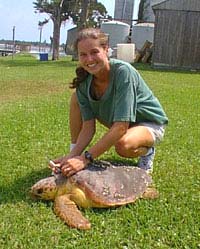Sea turtle health linked to contaminants

Jennifer Keller prepares to take a blood sample from a loggerhead sea turtle as part of her doctoral studies at Duke University. Keller is now a NIST post doctoral researcher. <br>Photo by Larisa Avens/NMFS
Loggerhead sea turtles may be getting sick because of environmental exposure to toxic organic chemicals, such as polychlorinated biphenyls (or PCBs) and pesticides, according to a new study led by Duke University, with collaboration from the National Institute of Standards and Technology (NIST), and other organizations.
Released on April 21 in the online edition of Environmental Health Perspectives, the study found that turtles with higher concentrations of contaminants had poorer health. The authors note that the correlations suggest, though do not prove, a cause-and-effect link.
The new study is the first to investigate sea turtle health effects linked to a class of chemicals called organochlorines that are known to sicken other wildlife. Scientists took blood and fat samples from 48 live juvenile turtles captured in North Carolina waters and carried out clinical health assessments. Duke then worked with NIST researchers to measure the samples for concentrations of 80 different PCB and pesticide compounds. The research team found significant correlations for a wide variety of biological functions, suggesting, for example, changes in the immune system, possible liver damage, and possible alterations in protein and carbohydrate regulation.
The data may help scientists understand and address population declines in sea turtles, all species of which are threatened or endangered.
The NIST work was performed at the Hollings Marine Laboratory in Charleston, S.C., in which NIST is a partner. Researchers from the New England Aquarium and North Carolina State University also collaborated on the sea turtle research. Funding was provided by the Morris Animal Foundation, Disney Wildlife Conservation Fund, Oak Foundation, and Duke University Marine Biomedical Center.
Media Contact
More Information:
http://www.nist.gov/All latest news from the category: Ecology, The Environment and Conservation
This complex theme deals primarily with interactions between organisms and the environmental factors that impact them, but to a greater extent between individual inanimate environmental factors.
innovations-report offers informative reports and articles on topics such as climate protection, landscape conservation, ecological systems, wildlife and nature parks and ecosystem efficiency and balance.
Newest articles

A ‘language’ for ML models to predict nanopore properties
A large number of 2D materials like graphene can have nanopores – small holes formed by missing atoms through which foreign substances can pass. The properties of these nanopores dictate many…

Clinically validated, wearable ultrasound patch
… for continuous blood pressure monitoring. A team of researchers at the University of California San Diego has developed a new and improved wearable ultrasound patch for continuous and noninvasive…

A new puzzle piece for string theory research
Dr. Ksenia Fedosova from the Cluster of Excellence Mathematics Münster, along with an international research team, has proven a conjecture in string theory that physicists had proposed regarding certain equations….



